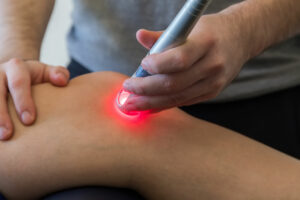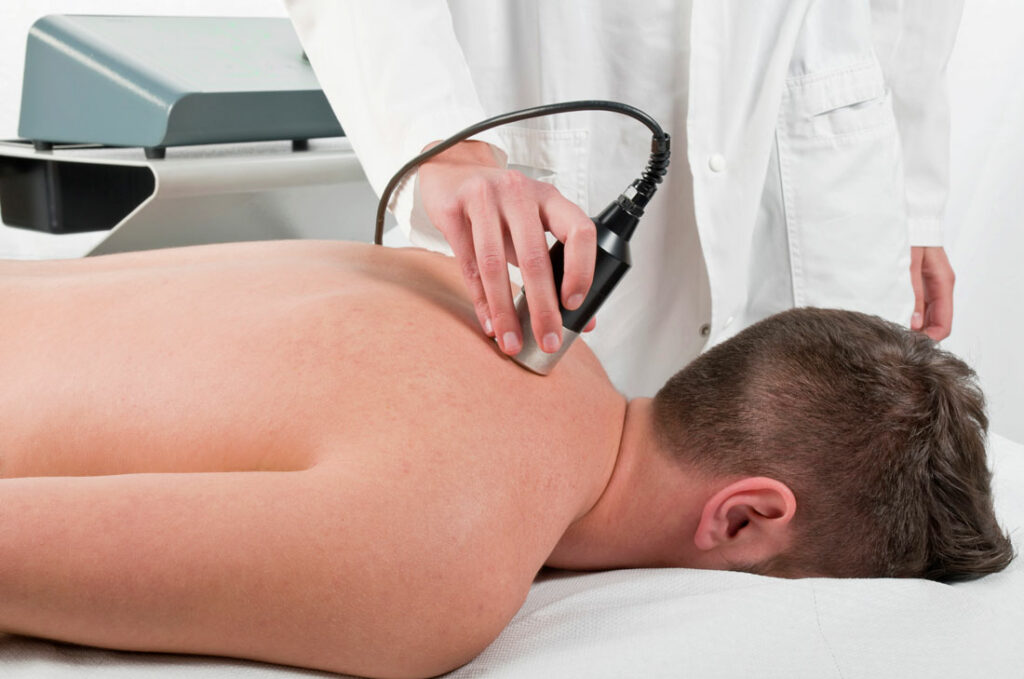Ultrasound is a sound wave with a frequency above the range of human hearing. Physical therapists use ultrasound to help treat musculoskeletal injuries and improve healing after auto accidents, work accidents and related incidents.
Ultrasound physical therapy can help to:
- Reduce pain
- Reduce inflammation
- Increase blood flow
- Improve healing time
- Release muscle tension
Contact us today for:
How Ultrasound Works

Inside the therapeutic ultrasound unit is a piezoelectric ceramic crystal. When electrical current is passed through the crystal, it vibrates at a very high frequency. This vibration produces sound waves that are then passed through a gel into the patient’s body. The sound waves then bounce off internal tissues and produce tiny vibrations. These vibrations help to:
- Reduce pain by stimulating nerves that block pain signals from reaching the brain
- Reduce inflammation by increasing blood flow and lymphatic circulation
- Release muscle tension by breaking up adhesions and scar tissue
- Improve healing time by increasing collagen production and cell metabolism
During treatment, ultrasound waves are passed through a water-based gel that helps to create a seal between the transducer and the skin. The sound waves used in ultrasound therapy don’t travel well through the air, so this seal is important in order to prevent any air pockets from forming.
Deep Heating Effects of Therapeutic Ultrasound

At depths of 1-3 cm, ultrasound waves cause a deep heating effect. The deep heating effects of ultrasound are thought to be caused by frictional forces created as the sound waves travel through the tissues. These frictional forces cause the internal temperature of the tissue to rise, which can help to decrease chronic pain, inflammation and muscle spasms.
Other Effects of Therapeutic Ultrasound

This therapy also introduces energy into the body, which causes the formation of microscopic gas bubbles. These microscopic bubbles rapidly expand and contract, which creates a cavitation effect. The cavitation effect can help to break down scar tissue and adhesions. It also helps to increase blood flow and the release of pain-relieving chemicals, such as endorphins and serotonin.
Ask About Our Therapeutic Ultrasound Therapy

Let’s get in touch! If you have suffered an injury, we can help. We offer a variety of services that can improve your quality of life. Therapeutic ultrasound, in conjunction with other treatments, can be part of the ideal physical therapy regimen that can promote healing quickly. Get in contact with our Brevard chiropractic center today!
Frequently Asked Questions
What Does Therapeutic Ultrasound Feel Like?
For most people, therapeutic ultrasound feels like a warm massage. You may feel a slight tingling sensation as the sound waves penetrate your skin. The intensity of the ultrasound can be adjusted to increase or decrease the level of comfort. Most people tolerate this treatment well and do not experience any side effects. In rare cases, some people may develop a mild rash at the site of treatment.
How Effective Is Therapeutic Ultrasound?
This therapy has a high rate of success for injury types like tendonitis, bursitis, and plantar fasciitis. There is also some evidence to suggest that therapeutic ultrasound may help speed the healing process for certain types of fractures. A physical therapist will design a customized treatment plan based on the type and severity of your injury. This plan may includes other modalities like electrical stimulation, exercises and ice or heat therapy.
Is Therapeutic Ultrasound Safe If Pregnant?
If you are pregnant, you should avoid this therapy as there is a potential for it to cause harm to the developing baby.
What Are the Side Effects of Therapeutic Ultrasound?
Most people tolerate therapeutic ultrasound well. However, some people may develop a mild rash at the site of treatment.
Can You Use Therapeutic Ultrasound With a Pacemaker?
If you have a pacemaker, you should not have this type of therapy as the ultrasound waves can interfere with the pacemaker’s function.
What Happens During Therapeutic Ultrasound?
A physical therapist will apply a gel to your skin and then place the ultrasound probe on the area being treated. The probe emits ultrasonic waves that penetrate deep into your tissues. You may feel a slight warmth during the treatment. The length of time for each treatment session depends on the condition being treated. Most sessions last between 15 and 30 minutes.
How Often Should I Have Therapeutic Ultrasound?
Your physical therapist will design a treatment plan based on your individual needs. Treatment frequency will depend on the condition being treated and its level of severity.

